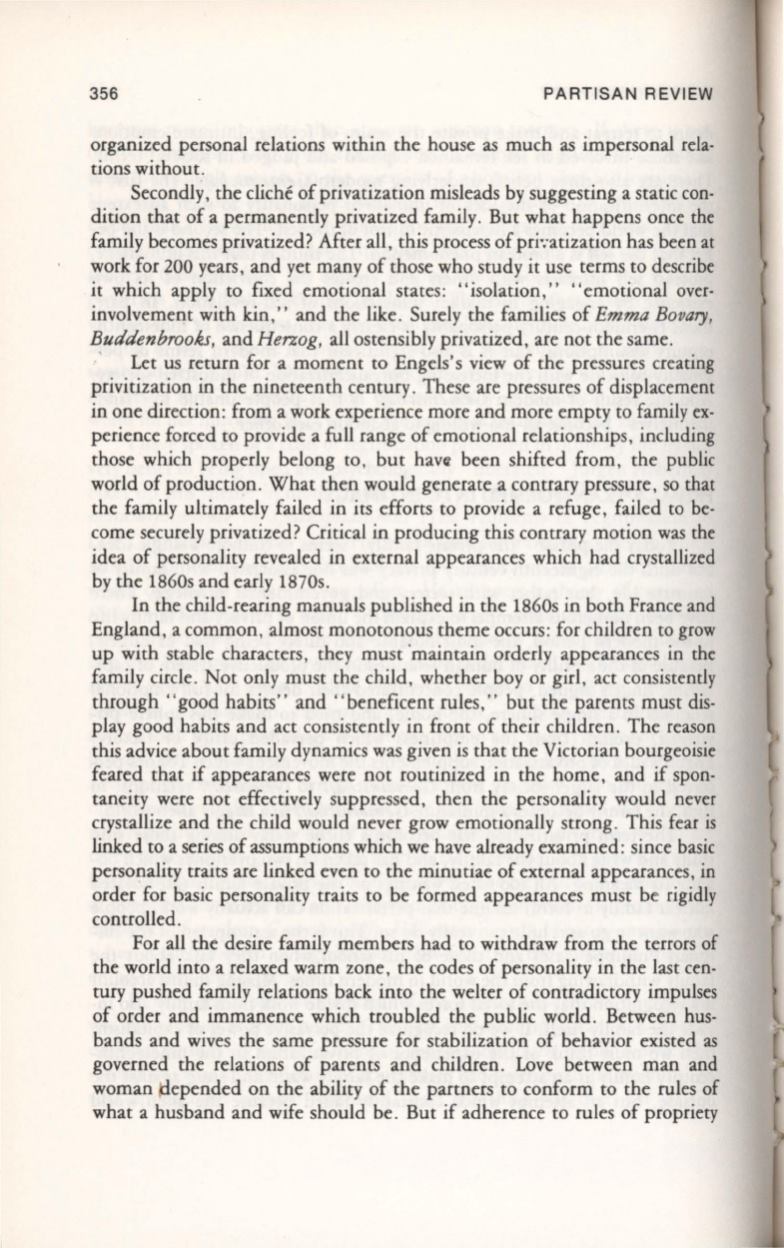
356
PARTISAN REVIEW
organized personal relations within the house as much as impersonal rela–
tions without.
Secondly, the cliche of privatization misleads by suggesting a static con–
dition that of a permanently privatized family . But what happens once the
family becomes privatized? After all, this process of pri';atization has been at
work for 200 years, and yet many of those who study it use terms to describe
it which apply
to
fixed emotional states: "isolation, " "emotional over–
involvement with kin, " and the like . Surely the families of
Emma Bovary,
Buddenbrooks,
and
Herzog,
all ostensibly privatized, are not the same.
, Let us return for a moment to Engels's view of the pressures creating
privitization in the nineteenth century. These are pressures of displacement
in one direction : from a work experience more and more empty to family ex–
perience forced to provide a full range of emotional relationships, including
those which properly belong
to ,
but hav¢ been shifted from, the public
world of production. What then would generate a contrary pressure, so that
the family ultimately failed in its efforts to provide a refuge, failed
to
be–
come securely privatized? Critical in producing this contrary motion was the
idea of personality revealed in external appearances which had crystallized
by the 1860s and early 1870s.
In the child-rearing manuals published in the 1860s in both France and
England , a common, almost monotonous theme occurs : for children
to
grow
up with stable characters, they must 'maintain orderly appearances in the
family circle. Not only must the child, whether boy or girl, act consistently
through "good habits" and "beneficent rules," but the parents must dis–
play good habits and act consistently in front of their children. The reason
this advice about family dynamics was given is that the Victorian bourgeoisie
feared that
if
appearances were not routinized in the home, and if spon–
taneity were not effectively suppressed, then the personality would never
crystallize and the child would never grow emotionally strong. This fear is
linked to a series of assumptions which we have already examined: since basic
personality traits are linked even
to
the minutiae of external appearances, in
order for basic personality traits to be formed appearances must be rigidly
controlled.
For all the desire family members had
to
withdraw from the terrors of
the world into a relaxed warm zone, the codes of personality in the last cen–
tury pushed family relations back into the welter of contradictory impulses
of order and immanence which troubled the public world. Between hus–
bands and wives the same pressure for stabilization of behavior existed as
governed the relations of parents and children. Love between man and
woman
~epended
on the ability of the partners
to
conform
to
the rules of
what a husband and wife should be . But if adherence to rules of propriety


